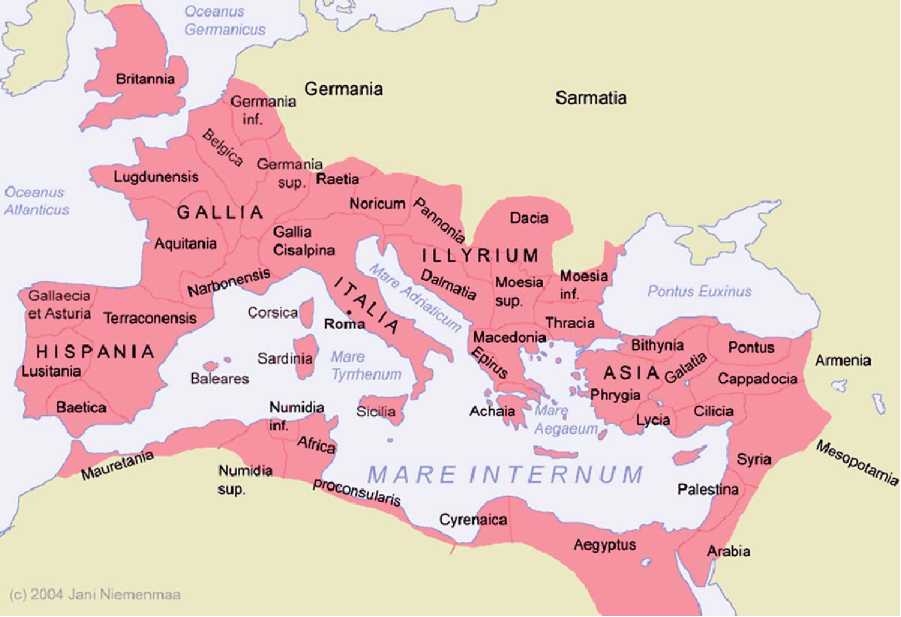Roman imperial expansion in the eastern Mediterranean was a consequence of the inheritance of land, the subduing of enemies and the quest for economic resources leading to a significant growth of the Empire from the late third century BCE. The Macedonian Wars (215-148 BCE), followed by the Mithridatic Wars (88-63 BCE) in addition to the series of Roman Civil wars (88-30 BCE) meant that by the death of Pompey in 48 BCE areas such as Epirus, Macedonia, Achaea, and Asia (see Figure 1) were officially under Roman control. Pompey had secured many of the Eastern provinces and subsequently, Caesar and Augustus were responsible for much of the organization and consolidation of the Eastern Empire. The institution of Roman rule in the provinces was manifested diversely; the joining of provinces, the consolidation of the geographical mass, inclusion of client kingdoms and the installation of armies, and comprehensive new administration. Provinces were established as administrative and political units and were controlled by governors, who were formally either Propraetors or Proconsuls and appointed by the Senate or the Emperor, thus creating ‘senatorial’ and ‘imperial’ class provinces. Imperial provinces were officially governed by the Emperor with a legate as his representative, were often established in areas of instability, buffer zones, or potential flashpoints and thus had a high military presence (hosting one or more legions), for example, Moesia. Although Egypt had a legion posted there, it was an Imperial province of a special kind with an Equestrian governor, as was Judea (at times). Once a province was firmly established with a governor appointed from Rome, unless there were mitigating circumstances or particularly vehement opposition to Roman rule, the local population (more often its elite elements) was commonly incorporated into regional government positions. The Letters of the Younger Pliny are especially enlightening for an understanding of the relationship between a Roman governor, his entourage, and the local population in the Eastern provinces. The roles of the governors were varied and they were expected to oversee administration, to ensure peace (at a range of levels), to warrant maintenance of the communication routes and upkeep of the cities, preservation of religious and entertainment facilities, and essentially, to guarantee the collection of taxes for Rome.
The geographical boundaries of provinces were not static. Although the limes identified in the physical remains of the frontier forts and watchtowers, indicate the boundaries of the Empire at different times, it is arguable that they were as much about monitoring the unconquered tribes as defining the extent of the

Figure 1 The Provinces (Permission is granted to copy, distribute and/or modify this document under the terms of the GNU Free Documentation License, Version 1.2 or any later version published by the Free Software Foundation; with no Invariant Sections, no Front-Cover Texts, and no Back-Cover Texts. A copy of the license is included in the section entitled ‘‘GNU Free Documentation License’’).
Empire (e. g., as fieldwork undertaken on the Limes Arabicus is showing). An awareness of the traditional political borders between provinces was maintained and while broad generalizations regarding the cultures of the Eastern Roman Empire are futile, the Roman army functioned directly and indirectly as a unifying element. Their tours of the Empire further stimulated communication between provinces, particularly through provision of food supplies and created an element of commonality through their presence and their maintenace of the built landscape.
Just as the Emperor had to be constantly on guard against potential uprisings in Rome, the provinces, particularly those with a significant military presence, could be a breeding ground for future challenges to the Emperor. As such, the size and nature of a province could change to combat growing power bases, for example, Moesia was subdivided and by 211 CE Syria had been divided into three provinces. Provinces could also be merged and in some cases the reasoning behind this is not always clear, for example Crete and Cyrene were joined together to become a single administrative unit. Pisidia was originally given to Cappadocia in the second century BCE to govern, but when this failed it was joined with Galatia in the late first century BCE. Lycaonia was divided between Galatia, Cappadocia, and Cicilia and following a series of border changes she finally became a separate province in CE 371.
A historical framework for the foundation and organization of the Eastern provinces is achievable through a collation of sources such as Dio, Livy, Pliny, Suetonius, and Tacitus. The density of written culture in the East allows a view of the significant events and key characters of the provinces is viable. Archaeological material such as pottery and other small finds, epigraphic and numismatic evidence, mortuary evidence, and architecture provide a much more coherent picture of the broader aspects of society and culture of the Eastern Roman provinces. In the past, much of the archaeological work has been focused in urban centers, although with the rise and refinement of archaeological survey methods, increasing attention is paid to the consideration of the rural landscape in the Roman period (e. g., work such as the Libyan Valleys project and the Pylos Regional Archaeological Project in the Peloponnese).
Scholars have explained the development and outcome of expansion and cultural change within the provinces through the application of processes such as Romanization, creolization, and globalization. A brief synopsis of these processes will allow for a more comprehensive understanding. Detailed discussion is available in the further reading section. Suffice is to say here that the nature of Roman provinces can be best understood through an examination of the archaeology in combination with the historical data to allow consideration of the perspective of the local population in addition to that of the Roman. As such this approach allows for a more inclusive understanding of the cultural change in the eastern Mediterranean with the growth of the Roman Empire.
The initial establishment of the provinces in the East was quite a different process from that of the West. In many respects urbanization was fundamental to the success of Roman occupation and the presence of the long established cities of the East meant that it was relatively straightforward for Roman administration to fit in. The populations of the East were already habituated to centralized administration. In addition, they had advanced technologies and stunning architecture. There were well-developed trade and communication networks and there was intense exploitation of agricultural and natural resources. In addition to the manifestations of conspicuous consumption, the populations of the East had a keen awareness of hierarchy and the machinations of politics. Rome had respect for the territories of the East and her policy seems to have been to undertake as little interference as possible, as long as peace was maintained to facilitate crucial tax collection.
Just as there are differences between the provinces and cities of the Eastern and Western Roman Empire, the archaeology of the East reveals that the provinces are as culturally diverse as they are geographically. There are few ‘model’ Roman cities; provinces become part of the Empire at different periods and for varied reasons. Their subsequent development as part of the Empire follow a multitude of progressions dependent on location, nature of the local population, economy, investment, etc. and a single scenario for provincial development is not appropriate.
The provinces were subsumed and cities were given different status at different times for numerous motives. There was no concurrent rate at which they grew and transformations within the cities, if any took place, occurred for a staggering multiplicity of reasons. The different levels of support for Rome were sometimes, although not always logically reflected in the level of privileges or punishment conferred. For example, Aphrodisias wholeheartedly supported Rome and experienced the economic benefits, in contrast Corinth was sacked. Some cities retained certain autonomous rights, such as Palmyra and Damascus, largely because of the benefits they provided for the Roman economy. These rights however were only valid as long as the cities behaved well. The foundation and subsequent growth of the Roman provinces was in some cases a planned strategic process, but more often there is little evidence throughout for a clearly defined unified policy. A study of the archaeology of the Eastern Roman Empire allows a broad range of perspectives and for such diversities to become apparent.




 World History
World History









